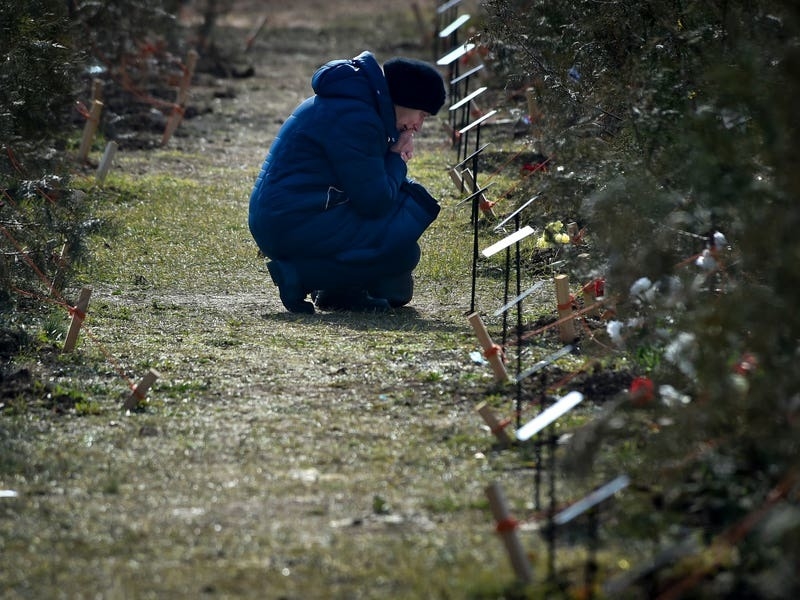Nearly 50,000 Russian men have died in the war in Ukraine, according to the first independent statistical analysis of Russia’s war dead.
Two independent Russian media outlets, Mediazona and Meduza, working with a data scientist from Germany’s Tubingen University, have used Russian government data to shed light on one of Moscow’s most closely-guarded secrets – the true human cost of its invasion of Ukraine.
Researchers relied on a statistical concept popularised during the Covid-19 pandemic called excess mortality. Drawing on inheritance records and official mortality data, they estimated how many more men under the age of 50 died between February 2022 and May 2023 than normal.
Neither Moscow nor Kyiv gives timely data on military losses, and each is at pains to amplify the other side’s casualties.

Reports about military losses have been repressed in Russian media, activists and independent journalists say.
Documenting the dead has become an act of defiance, and those who do so face harassment and potential criminal charges.
Despite such challenges, Mediazona and the BBC’s Russian Service, working with a network of volunteers, have used social media postings and photographs of cemeteries across Russia to build a database of confirmed war deaths.
As of July 7, they had identified 27,423 dead Russian soldiers.

“The estimate we did with Meduza allows us to see the ‘hidden’ deaths, deaths the Russian government is so obsessively and unsuccessfully trying to hide.”
To come up with a more comprehensive tally, journalists from Mediazona and Meduza obtained records of inheritance cases filed with the Russian authorities.
Their data from the National Probate Registry contained information about more than 11 million people who died between 2014 and May 2023.
According to their analysis, 25,000 more inheritance cases were opened in 2022 for males aged 15 to 49 than expected. By May 27 2023, the number of excess cases had shot up to 47,000.
That surge is roughly in line with a May assessment by the White House that more than 20,000 Russians had been killed in Ukraine since December, though this is lower than US and UK intelligence assessments of overall Russian deaths.

A leaked assessment from the US defence intelligence agency put the number of Russians killed in action in the first year of the war at 35,000 to 43,000.
“Their figures might be accurate, or they might not be,” Mr Treshchanin, the Mediazona editor, said in an email.
“Even if they have sources in the Russian ministry of defence, its own data could be incomplete. It’s extremely difficult to pull together all of the casualties from the army, Rosgvardia, Akhmat battalion, various private military companies – of which Wagner is the largest, but not the only one.
“Casualties among inmates, first recruited by Wagner and now by the ministry of defence, are also a very hazy subject, with a lot of potential for manipulation. Statistics could actually give better results.”
Independently, Dmitry Kobak, a data scientist from Germany’s Tubingen University who has published work on excess Covid-19 deaths in Russia, obtained mortality data broken down by age and sex for 2022 from Rosstat, Russia’s official statistics agency.
He found that 24,000 more men under age 50 died in 2022 than expected, a figure that aligns with the analysis of inheritance data.

Both analyses corrected for the lingering effects of Covid on mortality by indexing male death rates against female deaths.
Sergei Scherbov, a scholar at the International Institute for Applied Systems Analysis in Austria, cautioned that “differences in the number of deaths between males and females can vary significantly due to randomness alone”.
“I am not saying that there couldn’t be an excess number of male deaths, but rather that statistically speaking, this difference in deaths could be a mere outcome of chance,” he said.
Russians who are missing but not officially recognised as dead, as well as citizens of Ukraine fighting in units of the self-proclaimed Donetsk and Luhansk republics, are not included in these counts.
Mr Kobak acknowledged that some uncertainties remain, especially for deaths of older men.
Moreover, it is hard to know how many missing Russian soldiers are actually dead. But he said neither factor is likely to have a huge impact.
“That uncertainty is in the thousands,” he said. “The results are plausible overall.”
Meduza is an independent Russian media outlet that has been operating in exile for eight years, with headquarters in Riga, Latvia.
In April 2021, Russian authorities designated Meduza a “foreign agent”, making it harder to generate advertising income, and in January 2023, the Kremlin banned Meduza as an illegal “undesirable organisation”.
Moscow has also labelled the independent outlet Mediazona as a “foreign agent” and blocked its website after Russia’s full-scale invasion of Ukraine.






